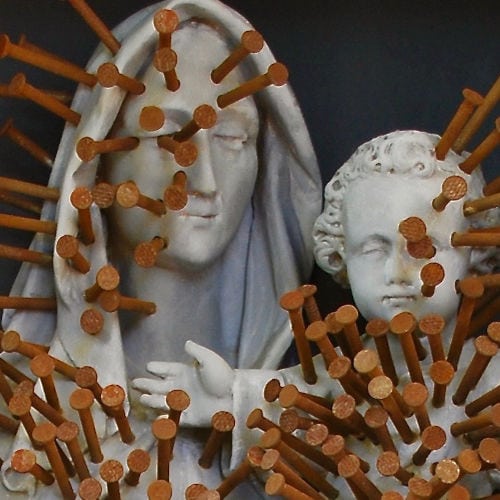Disturbing Heritage
The past is present through its lasting material forms, in open and hidden ways, marked and unmarked. Whether cherished, taken for granted or dismissed and left to decay, things from the past are subject to contested and conflicting political-aesthetic significations and frames.
We are in the midst of societal debates about the (in)suitability of certain things to anchor cultural memory and their commemorative value. Exactly for this reason, things are such an excellent entry point into broader matters of conflict, with regard to co-existence in plural religious environments or to the haunting presence of the colonial past, fascism, and other outrageous matters, as other essays in this thread also show.
Things that have lost their value, were left to decay or targeted for destruction can be scrutinized for alternative understandings of how past things matter in our global entangled world
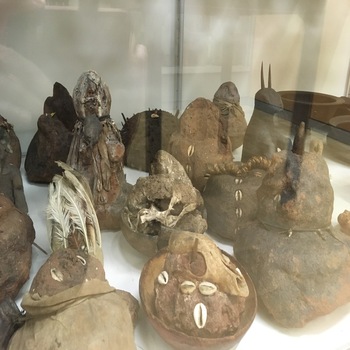
While heritage connotes an appreciative stance towards such things and recognizes their cultural value – for better or worse – in being kept in museums or as monuments, waste, is in many respects the Other of heritage. Things that have lost their value, were left to decay or targeted for destruction can be scrutinized for alternative understandings of how past things matter in our global entangled world: as haunting shadows, shady specters, or hidden time bombs, challenging how histories have been written, and the narratives and powers condoned by them. In many ways, heritage has run out of control – politically, but also epistemologically. A befitting scholarly response is to not only call attention to disturbingheritage, but above all to disturb heritage as a category and regime employed to authenticate certain things from the past as worth preserving. In line with the editors of this thread, I seek to question the boundaries of what counts as heritage, by bringing into the picture “undesirables” as “spirits, energies and waste.” These “undesirables” may be excluded from heritage as we know it, as a secular domain separate from religion, on the one hand, and from waste, on the other.
Based on my research on the rise of Christianity in Ghana, and the decline of Christianity in the Netherlands, in this essay I will take discarded things – and thus falling into the category of “waste” – as starting point. In Ghana, the rise and spread of Christianity in colonial times implied the framing of material forms central to indigenous religious traditions as “fetishes” and “idols” (fig.1) that were to be discarded, destroyed or taken to ethnographic museums, where they are still kept. In the Netherlands, where de-churching nowadays occurs on a massive scale, Christian things are abandoned and show up in many unexpected, mundane places (fig.2). The disintegration of indigenous religiosity in Ghana and Christianity in the Netherlands involves that things hitherto vested with sacrality are on the move, turned into waste, yet potentially up for being reframed and claimed as heritage.
Waste and/as heritage
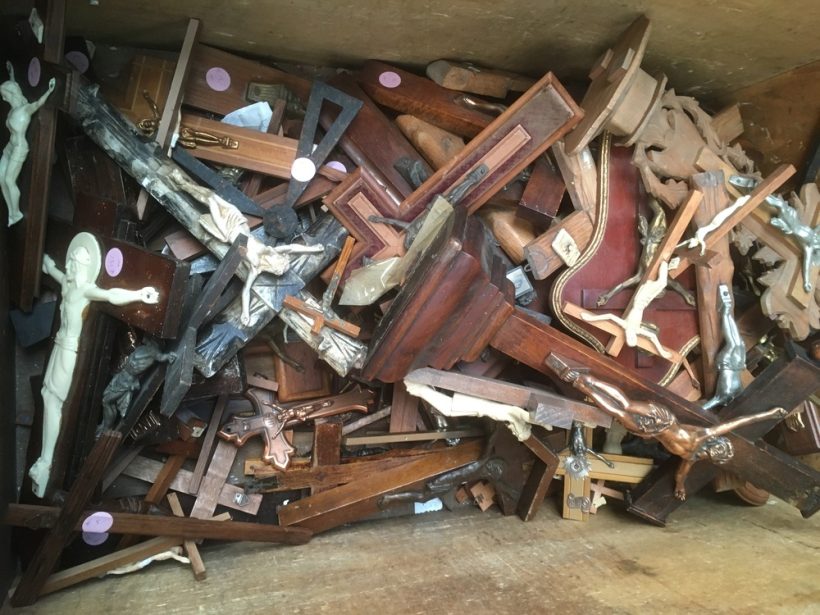
As laid out by William Viney, waste is a notion employed to signal the end of the use-time of a thing, which gave it a role for the future. If Mary Douglas’ notion of “matter out of place” regards dirt as a by-product of classification that disturbs a certain order, Viney’s conceptualizes waste as a “matter out of time”: “We make waste by removing a thing from use or removing use from a thing, but in both cases the time of the object becomes divided into a time of use and a time of waste” (2015:68-69). Qualifying an object as waste means that it has no use and future any longer. Discarded objects enshrine a past temporality, indexing a past that has ended and yet is present and potentially out of control.
History and heritage, as main cultural-political forms to remember the past, do not exhaust the past. Hence the need to think about waste, as a category employed in the making of time. Containing what is discarded and no longer of use, waste can also serve as an entry point into the politics that define what is valuable and useful, of what matters and what not. Looked at from this angle, the study of waste makes us aware of the temporality of things and alerts us to the shift undergone by things from a matter “in time” and in “place” to one “out of time” and “out of place”, and the narratives that go with it.
Religious things are ambiguous and prone to pollution, certainly when placed in settings that differ strongly from those of their previous religious use, meaning and value.
But there is even more, as these things once were operative in a religious setting, as harbingers of spirit power or as devotional objects. Irene Stengs coined the felicitous notion of “sacred waste” (2014) so as to refer to certain things that were loaded with a diffuse power through a process of sacralization and therefore cannot be disposed smoothly, but require special treatment and evoke a sense of unease. Religious traditions have all sorts of ways of dealing with sacred waste, via practices of cleansing and exit rites. What interests me here, however, is not how sacred waste is dealt with within a religious tradition, but how it is dealt with when a religious tradition goes down and its things fall apart in the secular domain. Religious things that become waste still carry some “sacred residue” (Beekers 2016), which makes them ambiguous and prone to pollution, certainly when placed in settings that differ strongly from those of their previous religious use, meaning and value. In high times of un-churching, as currently in the Netherlands, there is an excess of discarded things to worry about. The question arises which instances of discarded matter do not end up and disintegrate on the garbage heap of history, but are found to be eligible for a new status, use and future as heritage. Heritage, in other words, is a container category that is employed, in a selective, value-bestowing manner, to absorb sacred waste, turning it into “religious heritage.”
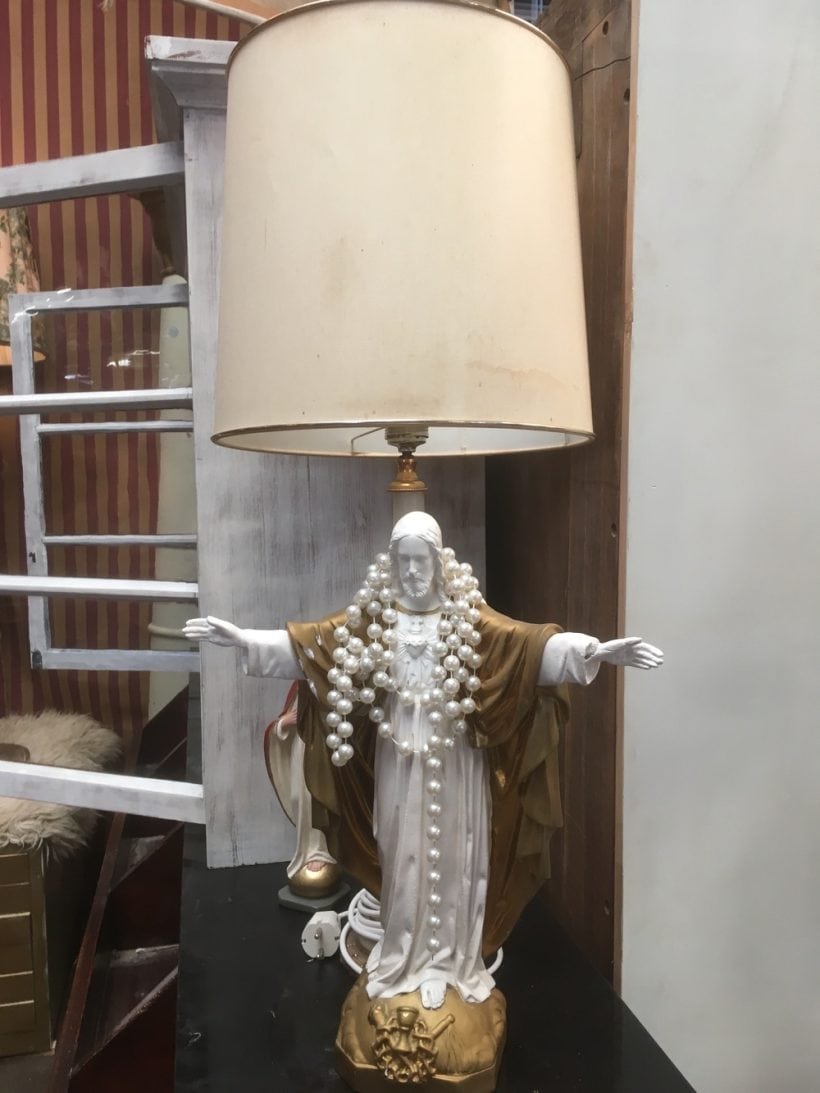
Religious heritage
Things qualified as “religious heritage” fall into the domain of secular heritage, with its own custodians, logic and regimes for preservation and display.
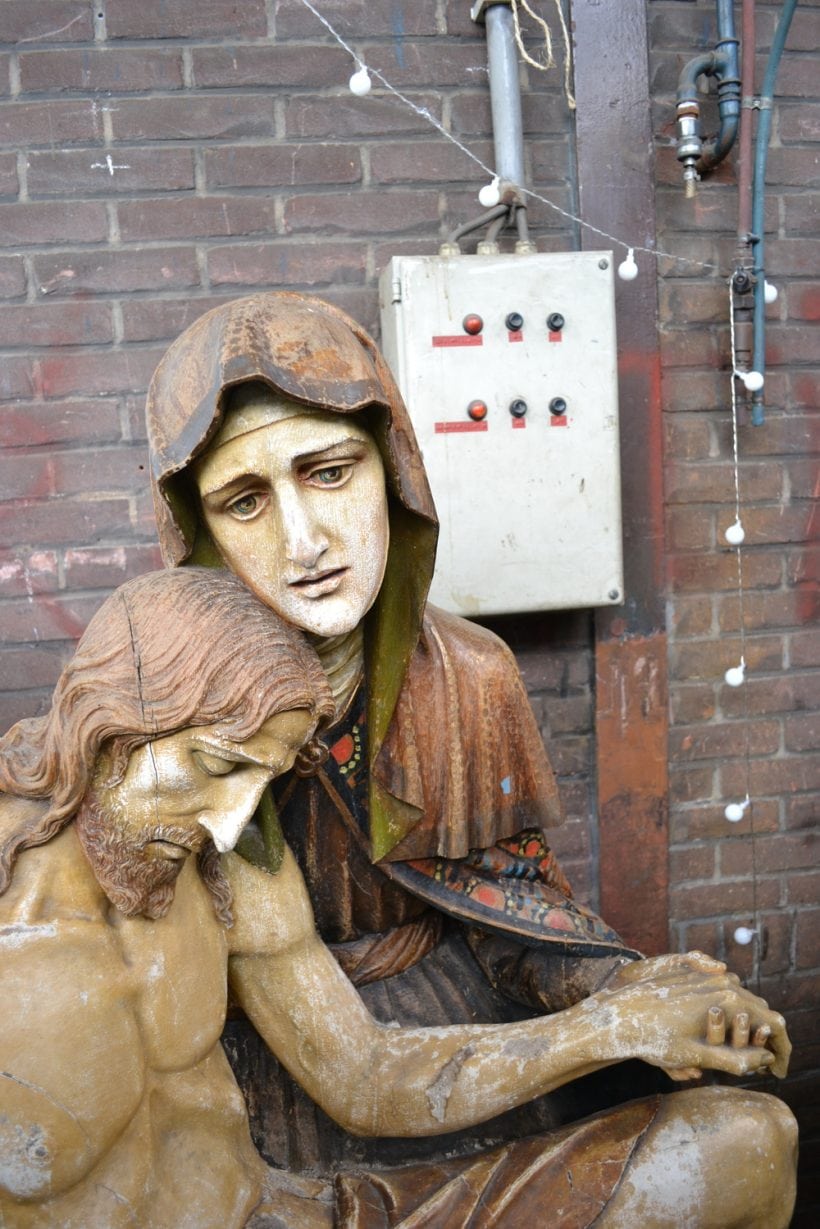
Currently, there is a great deal of Christian “waste” (fig.3&4) produced in the Netherlands, plastically illustrating the material break-down of Dutch people’s earlier strong affiliation with various strands of Christianity thriving through competition and schism. Some of these items are re-framed as “religious heritage.” The attribute “religious” refers to their past rather than their present use. In the same vein, the current claims laid to Europe’s Christian (or even “Judeo-Christian”) heritage, and the concomitant heritagization of Christianity (Hemel 2017, see also Burchardt 2020), do not require active belief and participation in a Christian church and involve a shift of ownership. The point is that things qualified as “religious heritage” fall into the domain of secular heritage, with its own custodians, logic and regimes for preservation and display. Exactly for this reason, the state and other secular instances can invest in its upkeep without trespassing the proverbial separation of church and state, in a way that would be more difficult to implement if the material forms would still be part of the regime of a church. Employing heritage as a secular frame allows state institutions and a broader secular public to bestow value on churches and other Christian things as relevant to society even though the churches themselves are shrinking and people are losing their faith.
In the same vein, museums are not bound to treat items from the Christian past in a religious manner, even though they may opt to show some courtesy, just as the re-use of former churches by new secular owners is sought to occur in a respectful, befitting manner, to respect the religious history of the building and the sentiments it still evokes. As part of a secular heritage regime, heritage institutions and museums have the possibility to engage with formerly Christian things in their own manner. They can take the risk to trigger a sense of offense in (Christian) visitors or even charges of blasphemy, as was the case with the exhibition Recycling Jesus in the Noordbrabants Museum in 2017 that displayed all sorts of artworks made of discharged and defunct Christian material forms (Meyer 2019) (fig. 5). Such playful work with the “sacred waste” that is left behind as material reminders of the sobering up of Catholicism in the aftermath of Vatican II, and the steady decline of Christianity spotlights the extent to which religious heritage has been severed from its Christian roots and thus become effectively secularized.
And yet, the process of heritagizing religion is not as smooth a transition from a religious to a secular regime as one might think. This is so because it involves a move from one value sphere (in the sense of Max Weber) to another, and thus a change from what Walter Benjamin (1999) called “cult value” to “exhibition value.” This pertains not only to Christian waste, but also to religious objects from other traditions. The question how to deal with discarded religious objects from former colonized areas – regarding preservation, display, and the ways in which visitors are invited to engage with them – is a matter debated hotly in heritage and museum circles. The urgency to address this issue is enhanced by the current public debates about the legacy of museums as colonial institutions that assembled a great deal of their objects – on display or in depots – under highly unequal power relations. Colonial collections contain many items from the sphere of outreach of European imperialism, waiting to be unpacked, scrutinized, and to some extent repatriated.
These items may still be alive and even hungry.

Against this backdrop, I just started research on a collection of legba-figures and dzokawo (“charms”) hosted by the Übersee-Museum Bremen that were assembled by missionaries of the Norddeutsche Missionsgesellschaft during their activities among the Ewe in the late 19th and early 20th century in the German colony Togo. Many of the items were gathered in the aftermath of Ewe converting to Christianity, as converts were to destroy their “heathen” things such as to break with their past – a logic of waste production on the part of missionaries that strongly resonates with Viney as well as with the emphasis placed on rupture in the anthropology of Christianity. Some were saved from the iconoclastic fire and taken to the museum in Bremen. For more than 100 years, they have been kept in the depot, with some on display in the Schaumagazin (fig.6). I approach the legba-figures and dzokawo as “religious matters” that enshrine colonial and post-colonial entanglements of people, objects and ideas in Africa and Europe that are to be unpacked in collaborative research that includes museum curators, archaeologists, anthropologists and priests from Germany and Ghana.
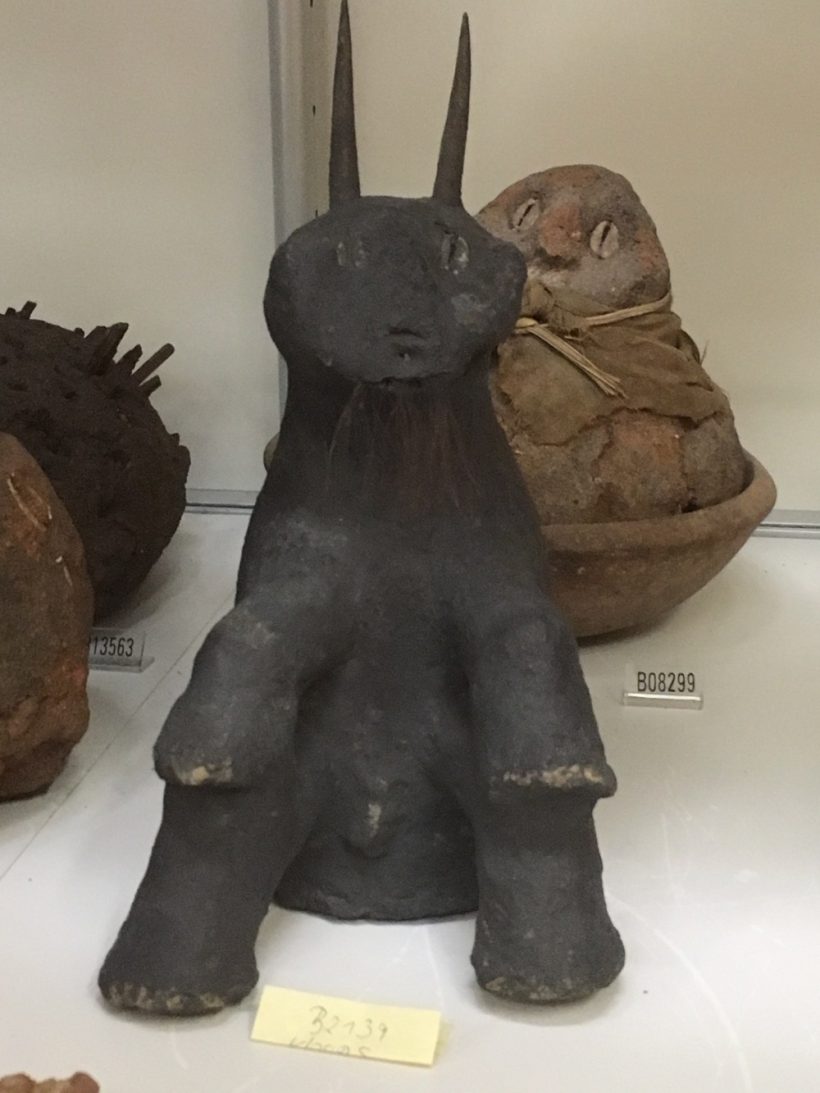
A preliminary insight I gained is that the current object-status of the legba-figures and dzokawo, implying that they have been emptied of their former spiritual forces, may be questioned. Upon seeing images of these items, the Ewe priest Christopher Voncujovi found they may still be alive and even hungry. While I initially thought about these items as having been stripped of the powers they were vested with in their original contexts and as evocative reminders of colonial missions’ activities in their fight against what they framed as instances of “heathendom,” his response alerted me to the fact that they may be found to still host spiritual forces. Ghana being strongly Christianized, many Christians would agree with the priest, yet in contrast to him regard them as dangerous and demonic and hence find it difficult to handle them even in the secular frame of the museum. Whether and when such things might at all be eligible to be recognized as religious heritage in Ghana remains to be seen.
***
Things in colonial collections may call for being re-animated and brought back into a religious regime, or they remain in between.
It is fruitful to probe into heritage from the angle of dissonant things that have fallen out of religion as lived. As matter out of time and place, such things are nodes to trace unexpected lines between past and present, and to spotlight unexpected entanglements of waste, heritage, and religion, and the material co-existence of different temporalities. The category of “religious heritage” into which both instances of sacred waste presented here fall appears to be an intriguing hybrid. While heritage is framed as secular, it contains things from the religious domain that still carry along their previous religious or “cult” value, for better or worse, depending on the beholder. This containment, through which the original religious use of things that became waste and were subsequently heritagized is still present, suggests that secularization is always haunted by the prior religious use of the things that it includes by virtue of marking the boundary that separates heritage from religion and waste. So, what we call “religious heritage” enshrines a complex entanglement of religion, waste and heritage, that can play out in multiple ways. While a likely future for Christianity in Europe may lie in its being recast as heritage, the things in colonial collections on display in exhibitions or kept in depots may call for being re-animated and brought back into a religious regime, or they remain in between. The focus on disturbing things that owe their accommodation in the frame of heritage to their becoming religious waste, offers a material ground for disturbingheritage in a political and epistemological sense that may that have repercussions for politics of identity and belonging in our entangled world.
Acknowledgement: With many thanks to the editors of this thread, Serawit Bekele Debele, Çiçek İlengiz and Annika Kirbis, for prompting me to write this essay, and Naomi Haynes for her thoughtful comments and suggestions on an earlier version.
References
Beekers, Daan. 2016 “Sakrale Residuen/Sacred Residue.” In The Urban Sacred – Städtisch-Religiöse Arrangements in Amsterdam, Berlin und London / How Religion Makes and Takes Place in Amsterdam, Berlin and London. Ausstellungskatalog/Exhibition Catalogue, edited by Susanne Lanwerd, 36–41. Berlin: Metropol. http://www.urban-sacred.org/index.html%3Fp=12689.html
Benjamin, Walter. 1999 (orig. 1936). “The Work of Art in the Age of Mechanical Reproduction.” In Illuminations, edited by Hannah Arendt, 211–44. London: Pimlico.
Burchardt, Marian. 2020. Regulating Difference: Religious Diversity and Nationhood in the Secular West. Ithaca, NY: Rutgers University Press.
Hemel, Ernst van den. 2017. The Dutch Wat on Easter. Secular Passion for Religious Culture & National Rituals. Yearbook for Ritual and Liturgical Studies 33: 1-19.
Meyer, Birgit. 2019. “Recycling the Christian Past. The Heritagization of Christianity and National Identity in the Netherlands.” In: Rosemarie Buikema, Antoine Buyse, Antonius Robben (eds.), Culture, Citizenship and Human Rights.London. New York: Routledge. Pp. 64-88. https://www.taylorfrancis.com/books/e/9780429198588
Stengs, Irene. 2014. “Sacred Waste.” Material Religion 10(2): 235-238.
Viney, William. 2015. Waste: A Philosophy of Things. London: Bloomsbury.

